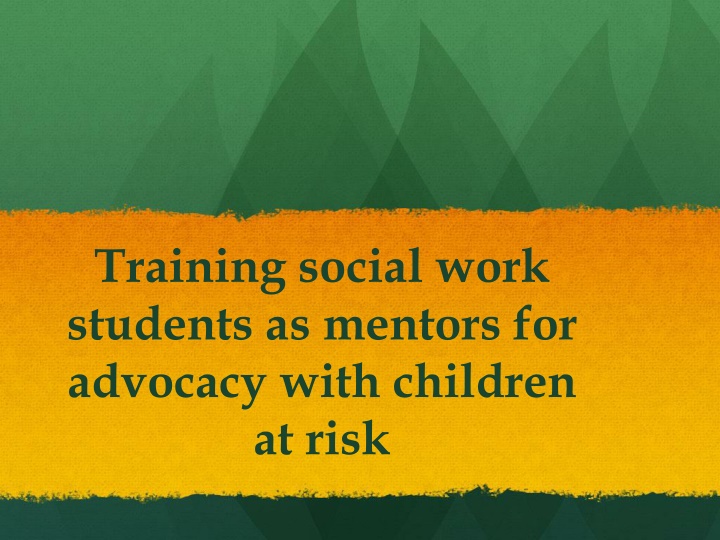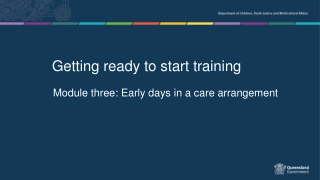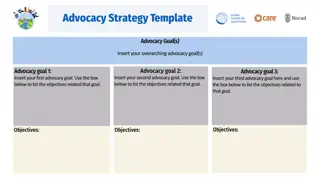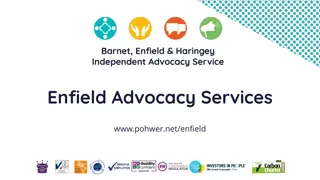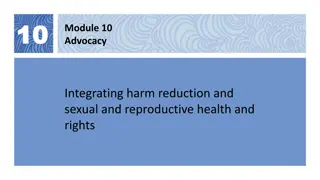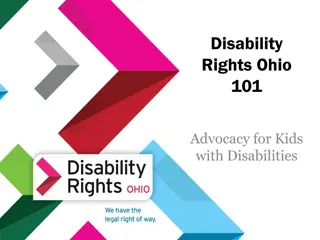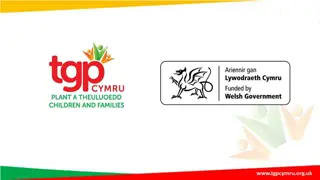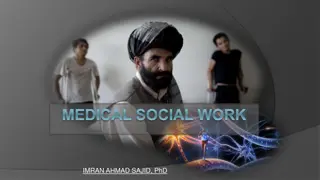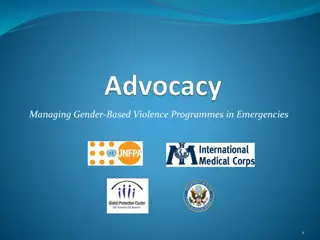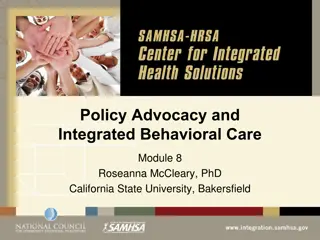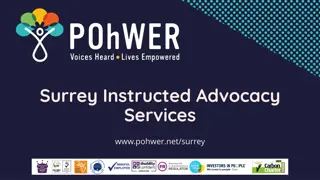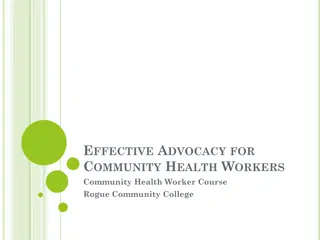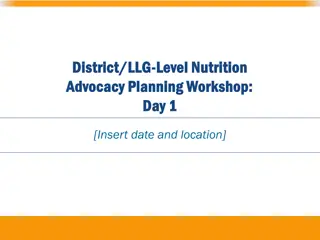Training Social Work Students for Advocacy with Children at Risk
Applied learning in social work education has gained significance, with programs emphasizing early practical experience. This study explores the benefits and challenges of training social work students as mentors for advocacy with children at risk. Through mentor relationships, successful advocacy can positively influence social, emotional, and behavioral outcomes, highlighting the importance of quality mentor-mentee connections. The rationale for the study focuses on students completing their first applied learning block in a real-world setting, such as Kennedy Middle Grade School.
Download Presentation

Please find below an Image/Link to download the presentation.
The content on the website is provided AS IS for your information and personal use only. It may not be sold, licensed, or shared on other websites without obtaining consent from the author.If you encounter any issues during the download, it is possible that the publisher has removed the file from their server.
You are allowed to download the files provided on this website for personal or commercial use, subject to the condition that they are used lawfully. All files are the property of their respective owners.
The content on the website is provided AS IS for your information and personal use only. It may not be sold, licensed, or shared on other websites without obtaining consent from the author.
E N D
Presentation Transcript
Training social work students as mentors for advocacy with children at risk
Denise Anderson, PhD Bry Williams, BSW Student Olivet Nazarene University
Background Applied learning has become an important part of education for social work majors over the last 20 years (Lucero, 2015). In 2014 almost 80% of social work programs identified they begin with applied learning in the early part of the program (Schelbe, Petracchi & Weaver, 2014). ONU, as well as many other programs (Phillips, 2011), require an applied learning block in SOWK 200 Introduction to Social Work. Little empirical research about service-learning in social work education (Schelbe, Petracchi & Weaver, 2014).
Benefits of Early Applied Learning Assists students in deciding if Social Work is where they desire to study and practice (Madden, Davis & Cronely, 2014) Promotes reflection (Lavender-Bratcher & Phillips, 2009) Networking and community connections (Schelbe, Petracchi & Weaver, 2014) Builds skills, knowledge and values (Weiler, et. al., 2013) Increases awareness of social justice (McGuire & Majewski, 2011) Increases cultural awareness and understanding diversity (Sanders, Haskings & Vasquez, 2015)
Challenges of Early Applied Learning Challenges on the field can deter students from wanting to go into social work Limited supervision/accountability Limited training/preparation of students Time available/transportation/logistics (Schelbe, Petracchi & Weaver, 2014)
Advocacy through mentor relationships There is evidence of successful advocacy in the area of social, emotional and behavioral outcomes (DeWit, et. al, 2006). The quality of the relationship (connection between mentor and mentee) as well as the length of time in mentoring relationship were significant in the overall impact (Herrara, et. al, 2007). Within only a few months of mentor relationship beginning, a positive impact was seen in mentee, but the positive impact only lasted about a year if mentoring ended (Rhodes, 2008)
Rationale for Current Study Students in SOWK 200 Introduction to Social Work have been completing their first Applied Learning block in Kennedy Middle Grade School for several years. Last year, with new administrators at the school, they felt the SW students were not benefiting the students Because the main reason was related to the students not being prepared, the process began to train the students as mentors (same training offered to community mentors)
Study Last semester a 2-hour mentor training was provided by Deb Tamaz, MSW (oversees Social Work Services in area school district) in the first week of classes Students were assigned to one of two schools: King Middle Grade (Kankakee) and Liberty Intermediate School (Bourbonnais) Liberty students were paired with mentees. King students were paired with a teacher.
Study A satisfaction survey was developed for both students and teachers/administrators IRB approval gained Surveys were distributed to students, teachers/administrators from last semester Surveys were given to students and faculty at the end of Spring semester. Qualitative data was collected in class discussion Comparison of both Pre and Post training as well as Classroom based and one-to-one mentoring
Results Students (pre-post training) Pre-Mentor Training (n=9) Post-Mentor Training (n=14) More training Postive Experience Pre- training Post- training Postive Impact Preparedness 0 1 2 3 4 5 6 7 8 9
Results-Students PRE-TRAINING I wish we had been given examples and scenarios of what to expect Teachers didn t always seem they wanted us there I didn t feel like I had any preparation for mentoring students I didn t know what to say to the students in the beginning Felt like I was thrown into the experience POST-TRAINING I learned more than I ever could in a classroom about issues faced by children It has been wonderful. I ve learned so much This should only be for social work majors. Experience was less than expected Communication with school is a challenge
Results- Teachers Pre-Mentor Training (n=3) Post-Mentor Training (n=14) More training Postive Experience Pre-training Post- training Postive Impact Preparedness 0 1 2 3 4 5 6 7 8
Results-Teachers PRE-TRAINING Mentors were great but it became a distraction for the classroom. Mentors were great, but the program needs more structure and the mentors need more training. Mentors had great attitudes but they lacked training: responding to abuse/neglect disclosures, when to involve staff, etc. Would be better to pair mentor/mentee POST-TRAINING Students loved having their mentor come meet with them. More communication between the mentor and teacher would be helpful
Results Students (Classroom vs. One- One Mentoring) Classroom-based (n=6) One-to-One Mentoring (n=8) Preparedness Classroom based One-to-One Mentor Positive Impact Positive Experience 0 5 10
Results-Students CLASSROOM BASED Teachers were not always accommodating Teachers didn t seem to know why we were there We never worked with the same students and couldn t build relationships Some of the time, we just sat in the classroom while the teacher was teaching The few times I was able to work one on one with a child were the best. They opened up more. ONE ON ONE MENTOR I was able to help children who were being bullied. I was able to grow personally through the mentoring relationship The relationship I developed with my mentee seemed to help how he was doing in school. He seemed more confident. My mentees seemed really excited each week I met with them.
Department Evaluation During each semester interviews when students are asked what they would change about the Social Work program, about 35% indicate they wish the applied learning in Introduction to Social Work were not in a classroom. Since this has changed to all one-to-one mentoring and we explain how it is currently set up, each has said they are pleased to hear the change in structure.
Recommendations Continue to train students as mentors but add case scenarios about how to respond to different issues mentees might be facing. Pair all mentors with 4-5 mentees in different schools so students can develop relationships and work more intentionally with mentee (similar to community mentoring program). Develop a form to fill out after each mentor session to help communicate with teacher and help mentor be more intentional.
Future Research Long-term studies with both mentors and mentees Gather data on children who have been in the mentoring program for at least one year Consider the impact of changing mentors each semester does this still help the mentee? Gather data on upper class students to determine long-term benefit of early mentoring.
References Council on Social Work Education. (2008). Educational policy and accreditation standards. Retrieved from http://www.cswe.org/Accreditation/Handbook.aspx DeWit, D. J., Lipman, E., Manzano-Munguia, M., Bisanz, J., Graham, K., Offord, D. R., O Neill, E., Pepler, D., & Shaver, K. (2006). Feasibility of a randomized controlled trial for evaluating the effectiveness of the Big Brothers Big Sisters community match program at the national level. Children and Youth Services Review, 29, 383 404. Herrera, C., Grossman, J. B., Kauh, T. J., Feldman, A. F., & McMaken, J. (with Jucovy, L. Z.). (2007). Making a difference in schools: The big brothers big sisters school-based mentoring impact study. Philadelphia, PA: Public/ Private Ventures Lavender-Bratcher, D. & Phillips, J. (2009). Young adult advocates supporting everyday youth: Developing mentoring relationships between college and high school students. Indianapolis, IN: NACSW Convention.
References Lucero, J. (2015). Engaging Undergraduate Social Work Students in Community-Based Research: Developing Research Skills Through Hands-On Learning. Council on Undergraduate Research, 35 (4), 18-24. McGuire, L. & Majewski, V. (2011). Social work and service-learning in the age of competency-based education. Advances in Social Work Education, 12 (1), i-vii. Papouli, E. (2014). Field Learning in Social Work Education: Implications for Educators and Instructors. Field Scholar, 4.2, 1-15. Phillips, A. (2011). Service-Learning and Social Work Competency- Based Education: A Goodness of Fit ? Advances in Social Work, 12 (1), 1-20.
References Rhodes, J. E. (2008). Improving youth mentoring interventions through research-based practice. American Journal of Community Psychology, 41, 35-42. Saunders, J. A., Haskins, M., & Vasquez, M. (2015). Cultural competence: A journey to an elusive goal. Journal Of Social Work Education, 51(1), 19-3 doi:10.1080/10437797.2015.977124 Schelbe, L., Petracchi, H. E., & Weaver, A. (2014). Benefits and Challenges of Service-Learning in Baccalaureate Social Work Programs. Journal Of Teaching In Social Work, 34(5), 480-495. Wrenn, J. & Wrenn, B. (2009). Enhancing Learning by Integrating Theory and Practice. International Journal of Teaching and Learning in Higher Education, 21 (2), 258-265.
